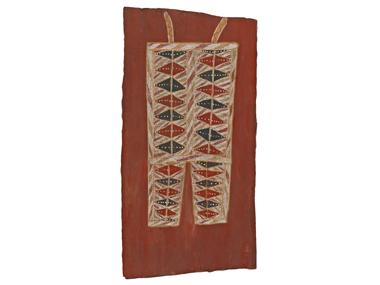Transformations: early bark paintings from Arnhem Land

Attributed to Makani Wilingarr, Ngarra minytji (Ngarra ceremony design) 1937, natural pigments of bark, 127x64.2cm, The Donald Thomson Collection, the University of Melbourne and Museum Victoria © Courtesy Jimmy Burinyila, Ramingining.
Posted by Aboriginal Art Directory | 09.10.13
Gallery: Ian Potter Museum of Art - The University of Melbourne
Dates:
13.11.13
: 23.02.14
Early works that embody a significant transition in Indigenous art practice will be on display in Transformations: early bark paintings from Arnhem Land, at the Ian Potter Museum of Art.
The paintings, many of which have never been previously exhibited, are the first representations on bark of important ancestral beings, sacred clan designs and totemic animals made specifically for outsiders. Collected between 1935 and 1950 by renowned anthropologist Professor Donald Thomson and ethnologist Dr Leonhard Adam from artists in Central and Eastern Arnhem Land, Caledon Bay and Groote Eylandt, these extraordinary paintings represent the beginnings of an intercultural language—one that has since evolved into a world renowned artistic tradition.
Curator, Joanna Bosse, says these paintings are some of the earliest translations onto bark of designs and motifs which were only previously painted on bodies, sacred objects and rock surfaces. “The immense and intricately detailed compositions of principal Yolngu painters from East Arnhem Land, such as Madarrpa artist Marawili Mundukul, display the depth of cultural knowledge, extraordinary painting skills and the willingness of these senior men to share aspects of their epistemology with outsiders.” Ms Bosse said.
Mundukul and others record onto bark ancient madayin minytji [sacred clan designs], which are normally painted on a man’s torso during ceremonies to embody the enduring power of totemic ancestors. A masterful suite of works depict anthropomorphic forms that reference the shoulders, torso and thighs of men (see artwork above), and illustrate the immediacy and inventiveness of transferring body markings to bark.
In contrast to Yolngu evocations of eternal ancestral presence, Groote Eylandt artist Minimini Mamarika paints totemic animals and narratives from the recent past—such as the visitation of Macassan trepang fishermen in the nineteenth century. Iconography characteristic of the island’s rock art feature floating forms on black manganese backgrounds unique to the region.
The University’s Donald Thomson Collection and Leonard Adam Collection of International Indigenous Culture are early collections of Indigenous material culture of historical and cultural significance.
The Donald Thomson Collection comprises Australian Aboriginal material primarily from Arnhem Land, the Cape York Peninsula in Queensland, and the Great Sandy and Tanami deserts in central Australia. The largest component was collected during Thomson’s, now famous, fieldwork in Arnhem land in 1935–37, and 1942. The remarkable bark paintings in this component of the collection, combined with Thomson’s extensive field notes, diaries and photographs, comprises a remarkable insight into Yolngu art-making and their perspectives on material culture.
Professor Donald Thomson (1901–1970) was a highly regarded anthropologist who held the post of Professor of Anthropology at the University of Melbourne 1964–68, as well as having a long-standing association with the University as a Research Fellow and Associate Professor. Thomson was the Research Fellow in Anthropology at Melbourne University 1923–37 and from 1945. During this period he undertook major expeditions to Cape York Peninsula, Arnhem Land and Central Australia, where he collected Aboriginal artefacts, as well as zoological specimens and information, and made an extensive photographic record of the indigenous people's lives and cultures. He retired in 1968 and died in 1970 - his ashes being scattered over Caledon Bay, NT.
The Donald Thomson Collection collection was transferred on loan to Museum Victoria in 1973.
The Leonhard Adam Collection of International Indigenous Culture was formed from 1942 to 1960 by Dr Leonhard Adam, a distinguished scholar and lecturer in the Department of History at the University of Melbourne. It comprises around 3000 objects from the indigenous cultures of North and South America, Africa, Melanesia, Asia and Australia.
In contrast the Thomson Collection—which was a consequence of collecting in the field—the Leonhard Adam Collection was formed through trade, acquisition and donation, using international networks and ad hoc opportunities to build the collection for teaching. The major component is Australian material, but in recent years we’ve been focusing our attention on the international holdings to enable us to introduce audiences to this material, which is rare within the Australian context.
Share this:
»  del.icio.us
»
del.icio.us
»  Digg it
»
Digg it
»  reddit
»
reddit
»  Google
»
Google
»  StumbleUpon
»
StumbleUpon
»  Technorati
»
Technorati
»  Facebook
Facebook
Contact Details
Gallery: Ian Potter Museum of Art - The University of Melbourne
Email: potter-info@unimelb.edu.au
Telephone: +61 3 8344 5148
Address: Swanston Street Parkville Melbourne 3010 Victoria
Where is the exhibition?
Further Research
Gallery: Ian Potter Museum of Art - The University of Melbourne
Artists: Makani Wilingarr
News Tags: Arnhem Land | Bark paintings | bark paintings | Cape York Peninsula | Donald Thomson Collection | Great Sandy Desert | Groote Eylandt | Ian Potter Museum | Joanna Bosse | Leonhard Adam Collection | Makani Wilingarr | Tanami Desert | University of Melbourne | Yolngu
News Categories: Australia
Exhibition Archive
- 02.06.20 | RIP Malu Gurruwiwi – Custodian of the Banumbirr
- 11.05.20 | BIDYADANGA CLOSE-UP
- 07.05.20 | Boomerang Back to the Start
- 29.04.20 | Cooked???
- 24.04.20 | Mrs Ngallametta
- 23.04.20 | NATSIAA Pre-Selections Revealed
- 20.04.20 | CIAF 2020
- 10.04.20 | Marginally Good News
- 06.04.20 | ON & OFF IN ABORIGINAL ART
- 26.03.20 | Out on Country!
- 19.03.20 | BIENNALE OF SYDNEY 2020
- 13.03.20 | LAURIE NILSEN
- 03.03.20 | EMILY v CLIFFORD
- 02.03.20 | The Ephemeral and the Ineradicable
- 25.02.20 | WADJUK IN THE BLACK
Advertising

